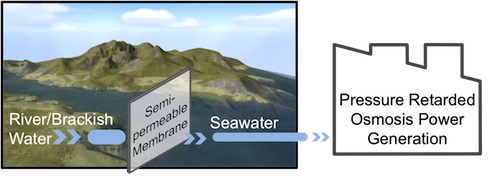Engineers Examine Water-Based Methods for Electricity Generation

As the world’s energy demands increase, Yale researchers are examining alternative and sustainable power generation techniques. Menachem Elimelech, the Roberto C. Goizueta Professor of Chemical & Environmental Engineering, has published extensively on using engineered osmosis to address the growing demand for energy. Now, in a co-authored piece with Professor Bruce Logan of the Pennsylvania State University in the journal Nature, Elimelech examines three water-based methods for electricity generation and the challenges that must be met before they can be used for widespread application.
The researchers highlight pressure-retarded osmosis (PRO), which uses the flow of water through membranes to produce pressurized water. The water then generates electricity using mechanical turbines. Past challenges to PRO have included inadequate flow from existing membranes; cellulose-acetate membranes designed specifically for use with PRO systems have significantly increased the achieved power density, while the researchers suggest that thin-film composite polyamide membranes will allow additional power density breakthroughs.

Membranes continue to be the main challenge to widespread use of PRO, however, with a need for both low-cost materials and those that offer minimal internal concentration polarization, which decreases power density. In addition, the researchers note that PRO requires extensive pretreatment of water to avoid fouling the membranes.
In examining reverse electrodialysis (RED), where electricity is generated directly from the difference in salinity between seawater and fresh water, the researchers note that water splitting, an element of the RED process, releases toxic chlorine gas from seawater, as well as potentially explosive hydrogen gas. The engineers suggest, however, that iron-based oxidation-reduction, or redox, could remove the need to split water in RED processes. They also highlight advances in increasing the approach’s power density as well as energy efficiency based on improvements in both membrane materials and their spacing and architecture. They note that the cost of ion-exchange membranes remains the primary challenge for commercial use of RED, but cite the development of new materials and increased production of membranes over the last decade as a driving factor in cost decreases, and speculate that a global increase in demand could lower costs.
Finally, the engineers examine microbial fuel-cell (MFC) technologies that generate energy from organic materials in wastewater, which can effectively make a wastewater treatment plant a power plant as well. While low power densities have limited efforts for the use of MFC systems in competition with other wastewater treatment systems in the context of power generation, the researchers note that modified MFCs can also be used for chemical remediation and produce hydrogen, methane, and acetate. Still, widespread use of such systems is challenged by electrode cost and longevity as well as instability and cost of cathodes.
The researchers conclude that all three of the examined processes require inexpensive, effective, and uniquely tailored membranes to achieve widespread use. With such advances, they suggest that salinity gradients, wastewater and biomass provide available sources of energy for renewable and sustainable power generation.
Bruce E. Logan and Menachem Elimelech. Membrane-based processes for sustainable power generation using water. Nature 488, 313–319 (16 August 2012). doi:10.1038/nature11477

